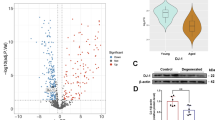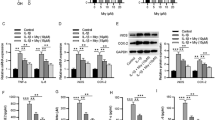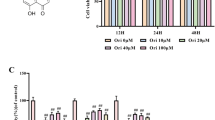Abstract
Degradation of extracellular matrix (ECM), reactive oxygen species (ROS) production, and inflammation are critical players in the pathogenesis of intervertebral disc degeneration (IDD). Evodiamine exerts functions in inhibiting inflammation and maintaining mitochondrial antioxidant functions. However, the biological functions of evodiamine and its related mechanisms in IDD progression remain unknown. The IDD-like conditions in vivo were stimulated via needle puncture. Hematoxylin and eosin staining, Safranin O/Fast Green staining and Alcian staining were performed to determine the degenerative status. The primary nucleus pulposus cells (NPCs) were isolated from Sprague–Dawley rats and then treated with tert-butyl peroxide (TBHP) to induce cellular senescence and oxidative stress. The cell viability was assessed by cell counting kit-8 assays. The mitochondria-derived ROS in NPCs was evaluated by MitoSOX staining. The mitochondrial membrane potential in NPCs was identified by JC-1 staining and flow cytometry. The expression of collagen II in NPCs was measured by immunofluorescence staining. The levels of mRNAs and proteins were measured by RT-qPCR and western blotting. The Nrf2 expression in rat nucleus pulposus tissues was measured by immunohistochemistry staining. Evodiamine alleviated TBHP-induced mitochondrial dysfunctions in NPCs. The enhancing effect of TBHP on the ECM degradation was reversed by evodiamine. The TBHP-stimulated inflammatory response was ameliorated by evodiamine. Evodiamine alleviated the IDD process in the puncture-induced rat model. Evodiamine promoted the activation of Nrf2 pathway and inactivated the MAPK pathway in NPCs. In conclusion, evodiamine ameliorates the progression of IDD by inhibiting mitochondrial dysfunctions, ECM degradation and inflammation via the Nrf2/HO-1 and MAPK pathways.






Similar content being viewed by others
References
Bai Z et al (2020) Protective effects of autophagy and NFE2L2 on reactive oxygen species-induced pyroptosis of human nucleus pulposus cells. Aging 12:7534–7548
Bermudez-Lekerika P et al (2022) Immuno-modulatory effects of intervertebral disc cells. Front Cell Dev Biol 10:924692
Clouet J et al (2009) The intervertebral disc: from pathophysiology to tissue engineering. Joint Bone Spine 76:614–618
Dimozi A et al (2015) Oxidative stress inhibits the proliferation, induces premature senescence and promotes a catabolic phenotype in human nucleus pulposus intervertebral disc cells. Eur Cell Mater 30:89–102
Dydyk AM, Ngnitewe Massa R, Mesfin FB (2023) Disc herniation. In: StatPearls. 2023, StatPearls Publishing LLC, Treasure Island
Eraslan E et al (2019) Evodiamine alleviates kidney ischemia reperfusion injury in rats: a biochemical and histopathological study. J Cell Biochem 120:17159–17166
Fan X et al (2017) Evodiamine inhibits zymosan-induced inflammation in vitro and in vivo: inactivation of NF-κB by inhibiting IκBα phosphorylation. Inflammation 40:1012–1027
Ge J et al (2020) The protein tyrosine kinase inhibitor, genistein, delays intervertebral disc degeneration in rats by inhibiting the p38 pathway-mediated inflammatory response. Aging 12:2246–2260
Global, regional, and national incidence, prevalence, and years lived with disability for 310 diseases and injuries, 1990–2015: a systematic analysis for the global burden of disease study 2015. Lancet, 2016. 388:1545–1602
Global, regional, and national incidence, prevalence, and years lived with disability for 328 diseases and injuries for 195 countries, 1990–2016: a systematic analysis for the Global Burden of Disease Study 2016 Lancet, 390:1211–1259 (2017)
Gruber HE et al (2013) Mitochondrial bioenergetics, mass, and morphology are altered in cells of the degenerating human annulus. J Orthop Res 31:1270–1275
Guo XX et al (2018) Evodiamine induces apoptosis in SMMC-7721 and HepG2 cells by suppressing NOD1 signal pathway. Int J Mol Sci. https://doi.org/10.3390/ijms19113419
Guo Q et al (2021) Targeting STING attenuates ROS induced intervertebral disc degeneration. Osteoarthritis Cartilage 29:1213–1224
Hayes AJ, Benjamin M, Ralphs JR (2001) Extracellular matrix in development of the intervertebral disc. Matrix Biol 20:107–121
Jin H et al (2019) Evodiamine inhibits RANKL-induced osteoclastogenesis and prevents ovariectomy-induced bone loss in mice. J Cell Mol Med 23:522–534
Johnson GL, Lapadat R (2002) Mitogen-activated protein kinase pathways mediated by ERK, JNK, and p38 protein kinases. Science 298:1911–1912
Jordan J, Konstantinou K, O’Dowd J (2011) Herniated lumbar disc. BMJ Clin Evid 2011:1118
Kepler CK et al (2013) Expression and relationship of proinflammatory chemokine RANTES/CCL5 and cytokine IL-1β in painful human intervertebral discs. Spine (Phila Pa 1976) 38:873–880
Kong M et al (2021) Myocardin–related transcription factor a nuclear translocation contributes to mechanical overload–induced nucleus pulposus fibrosis in rats with intervertebral disc degeneration. Int J Mol Med 48:1–13
Kuai J, Zhang N (2022) Upregulation of SIRT1 by evodiamine activates PI3K/AKT pathway and blocks intervertebral disc degeneration. Mol Med Rep 26:1–8
Le Maitre CL, Freemont AJ, Hoyland JA (2005) The role of interleukin-1 in the pathogenesis of human intervertebral disc degeneration. Arthritis Res Ther 7:R732–R745
Lee C (2018) Therapeutic modulation of virus-induced oxidative stress via the Nrf2-dependent antioxidative pathway. Oxid Med Cell Longev. https://doi.org/10.1155/2018/6208067
Li Y et al (2022) Silencing ATF3 might delay TBHP-induced intervertebral disc degeneration by repressing NPC ferroptosis, apoptosis, and ECM degradation. Oxid Med Cell Longev 2022:4235126
Liu X et al (2020) Sodium butyrate protects against oxidative stress in human nucleus pulposus cells via elevating PPARγ-regulated klotho expression. Int Immunopharmacol 85:106657
Livak KJ, Schmittgen TD (2001) Analysis of relative gene expression data using real-time quantitative PCR and the 2(-delta delta C(T)) method. Methods 25:402–408
Mao HJ et al (2011) The effect of injection volume on disc degeneration in a rat tail model. Spine (Phila Pa 1976) 36:E1062–E1069
Meng T et al (2021) Evodiamine inhibits lipopolysaccharide (LPS)-induced inflammation in BV-2 cells via regulating AKT/Nrf2-HO-1/NF-κB signaling axis. Cell Mol Neurobiol 41:115–127
Millward-Sadler SJ et al (2009) Regulation of catabolic gene expression in normal and degenerate human intervertebral disc cells: implications for the pathogenesis of intervertebral disc degeneration. Arthritis Res Ther 11:R65
Raj PP (2008) Intervertebral disc: anatomy-physiology-pathophysiology-treatment. Pain Pract 8:18–44
Risbud MV, Shapiro IM (2014) Role of cytokines in intervertebral disc degeneration: pain and disc content. Nat Rev Rheumatol 10:44–56
Shi Y et al (2019) Protective effects of evodiamine against LPS-induced acute kidney injury through regulation of ROS-NF-κB-mediated inflammation. Evid Based Complement Alternat Med 2019:2190847
Shin N et al (2020) p66shc siRNA-Encapsulated PLGA nanoparticles ameliorate neuropathic pain following spinal nerve ligation. Polymers (Basel). https://doi.org/10.3390/polym12051014
Son JK, Chang HW, Jahng Y (2015) Progress in studies on rutaecarpine. II.—synthesis and structure-biological activity relationships. Molecules 20:10800–10821
Wang Q et al (2021) Evodiamine protects against airway remodelling and inflammation in asthmatic rats by modulating the HMGB1/NF-κB/TLR-4 signalling pathway. Pharm Biol 59:192–199
Wu P, Chen Y (2019) Evodiamine ameliorates paclitaxel-induced neuropathic pain by inhibiting inflammation and maintaining mitochondrial anti-oxidant functions. Hum Cell 32:251–259
Xian S et al (2022) The protective effect of evodiamine in osteoarthritis: an in vitro and in vivo study in mice model. Front Pharmacol 13:899108
Xin J et al (2022) Treatment of intervertebral disc degeneration. Orthop Surg 14:1271–1280
Xue Y et al (2018) Evodiamine attenuates P2X(7)-mediated inflammatory injury of human umbilical vein endothelial cells exposed to high free fatty acids. Oxid Med Cell Longev 2018:5082817
Yang JY et al (2021) Evodiamine inhibits Helicobacter pylori Growth and Helicobacter pylori-induced inflammation. Int J Mol Sci. https://doi.org/10.3390/ijms22073385
Yang Y et al (2022) Evodiamine relieve LPS-induced mastitis by inhibiting AKT/NF-κB p65 and MAPK signaling pathways. Inflammation 45:129–142
Ye C et al (2021) Evodiamine alleviates lipopolysaccharide-induced pulmonary inflammation and fibrosis by activating apelin pathway. Phytother Res 35:3406–3417
Yin H et al (2019) Preventive effects of evodiamine on dexamethasone-induced osteoporosis in zebrafish. Biomed Res Int 2019:5859641
Youle RJ, van der Bliek AM (2012) Mitochondrial fission, fusion, and stress. Science 337:1062–1065
Zhang H et al (2020) Evodiamine attenuates adjuvant-induced arthritis in rats by inhibiting synovial inflammation and restoring the Th17/treg balance. J Pharm Pharmacol 72:798–806
Acknowledgements
We appreciate the support from the Wuhan Hospital of Traditional Chinese Medicine.
Funding
This work was supported by Wuhan Municipal Health Commission (approval number: WZ15B09).
Author information
Authors and Affiliations
Contributions
XG and TX were the main designers of this study. XG, TX, RP, WH, SD performed the experiments and analyzed the data. XG and TX drafted the manuscript. All authors read and approved the final manuscript.
Corresponding author
Ethics declarations
Conflict of interest
The authors have not disclosed any conflict of interests.
Ethical approval
The experimental protocols were granted approval from the Ethics Committee of Wuhan Myhalic Biotechnology Co., Ltd (No. 202007109) and abided by the National Institutes of Health Guide for the Care and Use of Laboratory Animals.
Additional information
Publisher’s Note
Springer Nature remains neutral with regard to jurisdictional claims in published maps and institutional affiliations.
Rights and permissions
Springer Nature or its licensor (e.g. a society or other partner) holds exclusive rights to this article under a publishing agreement with the author(s) or other rightsholder(s); author self-archiving of the accepted manuscript version of this article is solely governed by the terms of such publishing agreement and applicable law.
About this article
Cite this article
Xie, T., Gu, X., Pan, R. et al. Evodiamine ameliorates intervertebral disc degeneration through the Nrf2 and MAPK pathways. Cytotechnology 76, 153–166 (2024). https://doi.org/10.1007/s10616-023-00605-y
Received:
Accepted:
Published:
Issue Date:
DOI: https://doi.org/10.1007/s10616-023-00605-y




